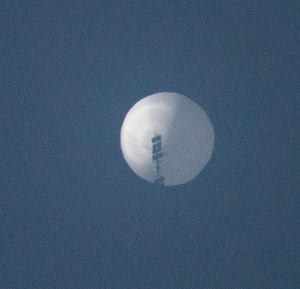The sighting of a Chinese balloon over northern Colombia and Costa Rica raised alarm in the Latin American region, due to the possible airspace violation.
The issue was not unknown to military intelligence officials. On February 4, the United States government had warned about the presence of an alleged “PRC surveillance balloon” over Latin America.
Days before, another balloon had crossed into U.S. airspace and was finally shot down with a missile over the Atlantic Ocean. After shooting down the first Chinese balloon off the coast of South Carolina, the U.S. government notified Latin American countries that a second balloon would be crossing over their territory.
The U.S. authorities identified that the balloon from China flew over Costa Rica and Nicaragua, passed through Colombian territory, and then entered Venezuela. “We are seeing reports of a balloon transiting Latin America,” Pentagon spokesman Pat Ryder said, describing the device as a “high-altitude surveillance balloon.”
Colombia
The Colombian Air Force said in a statement that it detected an “object above 55,000 feet, which entered Colombian airspace in the northern sector of the country, moving at an average speed of 25 knots, identifying characteristics similar to those of a balloon.” The air force said it had determined that the object did not “represent a threat to national security and defense, as well as to air safety.”
Using defense systems, the Colombian Air Force tracked the object until it left Colombia’s airspace.
Colombia is particularly concerned about three important military bases in the northern region where the balloon may have captured intelligence.
The first is the naval base in Cartagena, where the Colombian surface and submarine fleet is located. The second is the Air Command No. 3 base, home to several surveillance and reconnaissance aircraft. Finally, there is the base of the Cartagena Battalion and the Santa Barbara, which contains most of the armored and defense artillery pieces.
In recent weeks, Gustavo Petro, the Colombian president, received an invitation from the Chinese government to discuss Chinese investments in Colombia’s public works. In light of current events, it is feasible to assume that Petro will also raise the issue of the Chinese balloon that flew over Colombia without authorization, although he has not yet issued official concerns.
Costa Rica
In Costa Rica, President Rodrigo Chaves Robles said that the appearance of balloons from China “causes stress in world geopolitical relations.” He commented that after the passage of one such balloon over Costa Rican airspace, the government expressed its “concern” to China.
“Costa Rica, like all countries, wants and needs to ensure the integrity of its territory including airspace. We have expressed our concern to the Chinese government and we hope that this will not happen again,” the president noted.
Robles also expressed his hope that the United States and China “understand each other” after the crisis generated by the flights of Chinese balloons over different territories.
The Chinese embassy in Costa Rica said it regretted the events and reiterated to the Costa Rican authorities that the artifact did not represent “any threat to any country.” China’s explanation is that “the balloon that was observed from various points of the national territory was of a civilian character and had scientific purposes, mainly meteorological.”
The Costa Rican Foreign Ministry stated that it has taken note of the explanations received from its Chinese counterparts. “For the Ministry it is a priority to maintain its mission of safeguarding national sovereignty, demanding from the international community unrestricted respect for international law, sovereignty and the territorial integrity of our country,” the ministry said.
Both Nicaragua and Venezuela, countries aligned with China’s international strategy, have not commented on national security after the overflight of the balloon, but officials have supported China in the wake of U.S. actions.
China’s Response
Mao Ning, the spokesman of the Ministry of Foreign Affairs of China, acknowledged on February 6 that the balloon that flew over Colombia and several Latin American countries were owned by China, indicating that it had a civilian character and was used for flight tests.
“Affected by weather conditions and due to its limited self-control capability, the aircraft seriously deviated from its pre-established route and entered the airspace of Latin America and the Caribbean by mistake,” Mao said. “This incident was completely unexpected and caused by force majeure,” she added.
Mao also criticized the U.S. action in shooting down the balloon that had overflown the United States, saying that “the U.S. side, overlooking China’s repeated explanations, insisted on resorting to force, which is an overreaction. China resolutely opposes this.”
World tensions grew rapidly over China’s balloons. While the United States continues to demand explanations and maintain that they were instruments of espionage, the government of China will continue to hide behind a navigation error and its story that they are simple meteorological instruments. For their part, Latin American countries seem to prefer not to become embroiled in further controversy over this event.
The article was first published in Spanish in ReporteAsia.

































